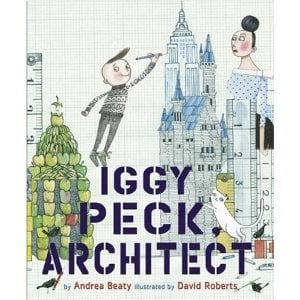
October 11, 2012
Children’s Books on the Built Environment
I have two kids, ages almost 6 and 3, and while they love reading books, I enjoy reading their books as much, if not more, than they do. I love the nostalgia and silliness of Dr. Seuss and Roald Dahl and the clever stories and terms that Mo Willems churns.The way my kids respond to books […]
I have two kids, ages almost 6 and 3, and while they love reading books, I enjoy reading their books as much, if not more, than they do. I love the nostalgia and silliness of Dr. Seuss and Roald Dahl and the clever stories and terms that Mo Willems churns.
The way my kids respond to books has shown me the power within their pages. One book can spark a new interest that lasts days, months – even years. One book can lead to the insistence that we read tens more on the same topic.
So naturally, I try to select books on topics that are also interesting to me (after all, I’m equally invested in reading these). This prompted an unofficial research project on children’s books about the built environment. With the exception of the immense stock of books about construction, trucks, trains, and planes, there are relatively few stories about the professions and interests of the designers and planners or about the shape and functions of cities, buildings, communities, neighborhoods, and parks themselves.
However disappointed I was by the brevity of my list, books like Iggy Peck, Architect by Andrea Beaty and The Little House by Virginia Burton have been inducted into our nightly favorites. (You can find my assuredly incomplete list of children’s books on landscape, architecture, planning and otherwise urban-related topics at the end of this post.)

A story about a talented little boy who builds architecture out of everything from chalk to dirty diapers
What is curious about this short list is that designers and planners love to publish books – but often these books are more effective as marketing tools for their services than as revenue generators from their royalties. Michael Crosbie, FAIA, who is currently the associate dean, architecture department chair, and associate professor at the University of Hartford and also edits Faith & Form magazine, has written more than 20 books on architecture. Five of these are specifically for children. Michael wrote a series of children’s book published by Wiley in 1993: Architecture Counts, Architecture Colors, Architecture Shapes, and Architecture Animals; in 2000 he wrote Arches to Zigzags which was published by Abrams. “The Wiley books have sold more than 120,000 copies, and continue to sell well nearly 20 years after publication, so they have by far been the most popular books I’ve ever written,” Michael says.

Watching my kids get excited by their books reminds me that I “discovered” the design and planning professions well after I established my career. Perhaps if I had read The Curious Garden by Peter Brown when I was five years old, I may have studied landscape architecture instead. From loosely polling my landscape, architecture, planner, urban designer friends, I’ve noticed that most of them chose their profession because they had a parent, uncle, aunt or family friend that was in a related profession. If this is how young people are still being recruited into studying design and planning, it’s no wonder why these fields suffer from a lack of diversity.
This is a missed opportunity! A children’s book that can be found in a public library can transcend races, genders, economic classes, and cultures. What’s the literary legacy you’d prefer, a silly picture book about a personal learning experience that inspired a little girl to pursue your vocation or the coffee table monograph that you’ll give to your clients?
Children’s Books Relating to Design or Planning of the Built Environment
- Roberto the Insect Architect by Nina Laden
- The Curious Garden, by Peter Brown
- ARCHES TO ZIGZAGS: An Architecture A B C, by Michael J. Crosbie
- Architecture Shapes, by Michael Crosbie
- Architecture Counts, by Michael Crosbie
- Architecture Colors, by Michael Crosbie
- Architecture Animals, by Michael Crosbie
- Not a Box, by Antoinette Portis
- Gargoyles, Girders & Glass Houses by Bo Zaunders
- Snail Trail: In Search of a Modern Masterpiece by Jo Saxton
- Two Bad Ants, by Chris Allsburg
- Island Boy, by Barbara Cooney
- Rome Antics, by David Macaulay
- Round Buildings, Square Buildings, and Buildings That Wiggle Like a Fish by Philip M. Isaacson
- Pop-up London, by Jennie Maizels
- Iggy Peck, Architect, by Andrea Beaty
- How a House Is Built, by Gail Gibbons
- The Three Little Pigs, by Steven Guarnaccia
- An Ants Day Off, by Nina Laden
- The Architecture Pop Up Book, by Anton Radevsky
- Draw Me a House: A Book of Colouring in, Ideas and Architectural Inspiration by Thibaud Herem
- The Little House, by Virginia Lee Burton
- The Cable Car and the Dragon, by Herb Caen
- Frank O. Gehry: Outside In, by Jan Greenberg and Sandra Jordan (10 years and up)
Did I leave one of your favorites off? Please comment with title and author.
Amanda Walter is a principal at Walter Communications where she helps landscape, architecture, and planning firms build thought leadership programs and strong reputations for their subject-matter experts through public relations, social media and strategic content development. She is the co-author of Social Media in Action: Comprehensive Guide for Architecture, Engineering, Planning and Environmental Consulting Firms, manages the AEC Idea Exchange community on Facebook and blogs about communications and not-business-as-usual trends in the design and planning industry.





